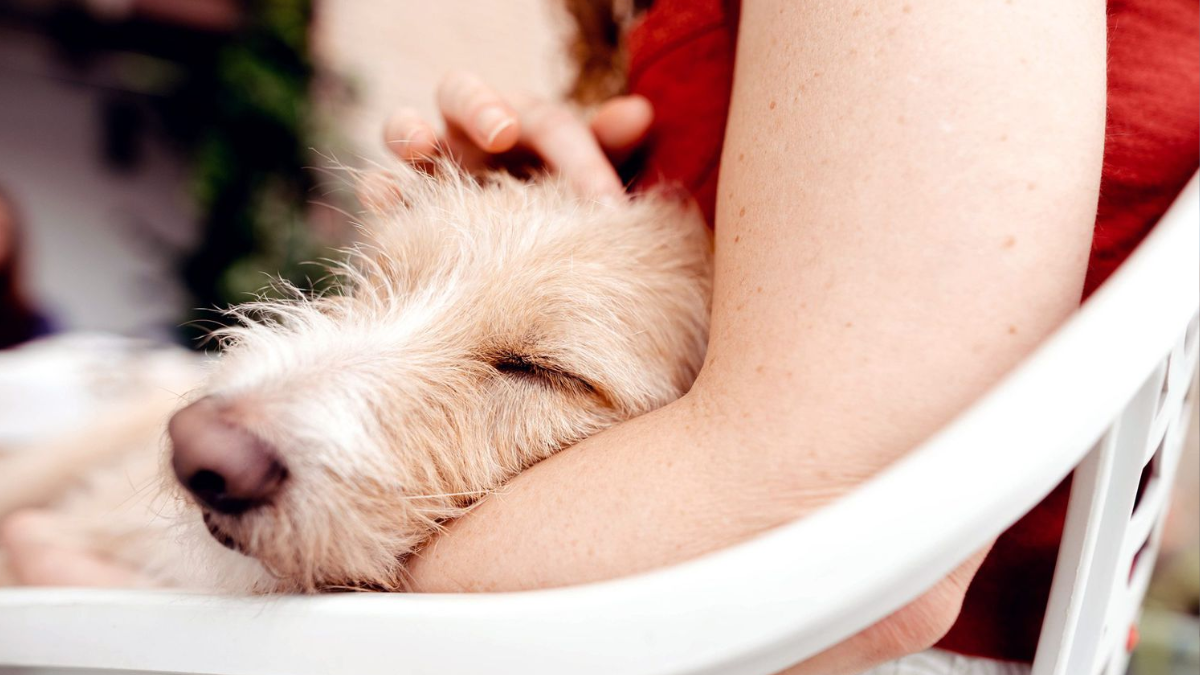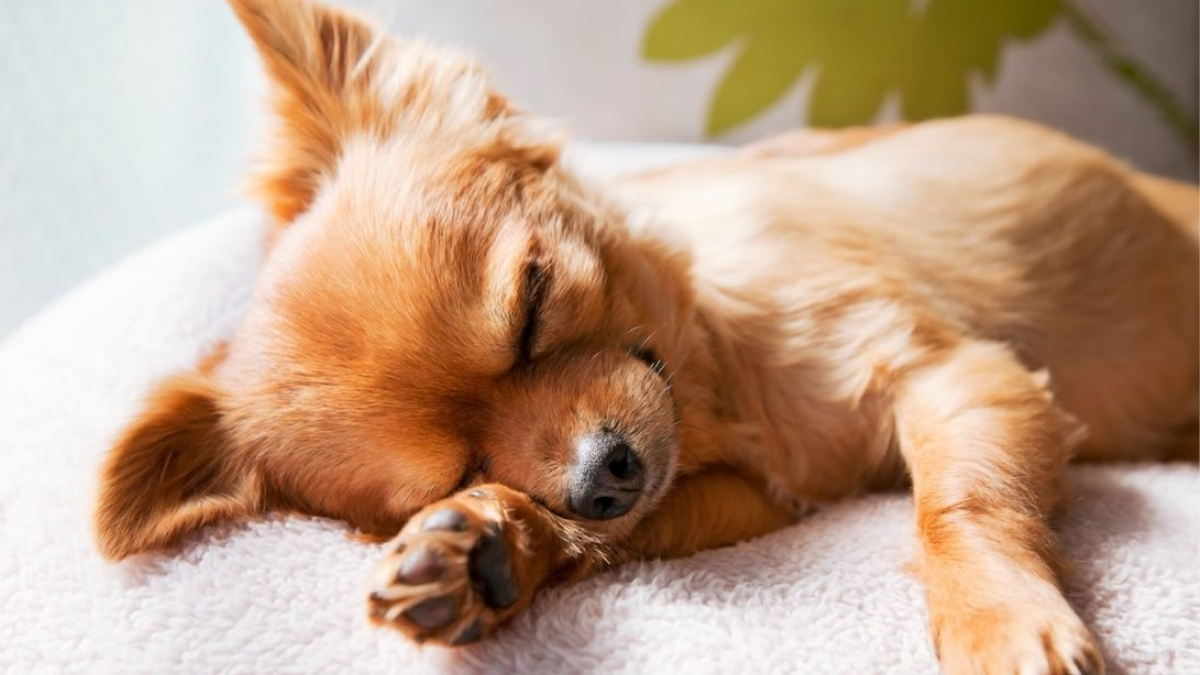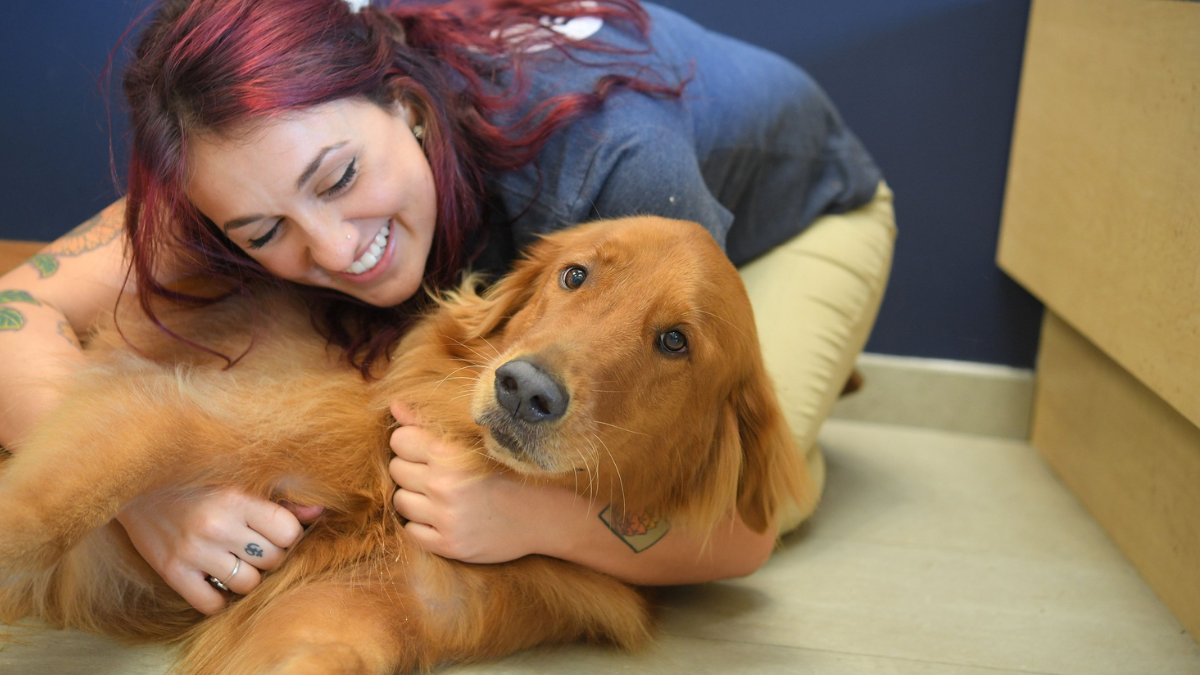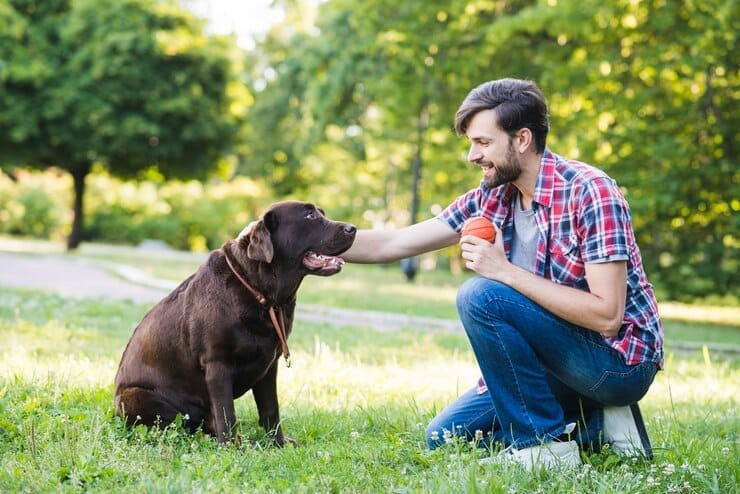Dogs are known for their adorable sleeping positions, from curling up into a ball to stretching out their legs. However, it can be concerning for pet owners to see their furry friend twitching while asleep. While it may look like your dog is having a nightmare or seizure, there are several reasons why dogs twitch while sleeping. Understanding Why Is My Dog Twitching While Sleeping? can provide insight into this common behavior. It could be a result of normal sleep cycles, dreaming, or involuntary muscle movements.

In some cases, twitching may indicate underlying health issues such as neurological problems or discomfort. However, occasional twitching during sleep is usually harmless and nothing to worry about. If you notice frequent or severe twitching, it's best to consult with your veterinarian for further evaluation. Overall, twitching while sleeping is a normal behavior for many dogs and is often a sign that they are experiencing deep and restful sleep.
Understanding Dog Sleep Twitching Dogs, like humans, go through different stages of sleep, including rapid eye movement (REM) and non-REM sleep. Twitching during sleep is common during the REM stage, which is when dogs are most likely to dream. During this stage, their brains are active, and they may twitch, whine, or even move their legs as if they are running.
Common Causes of Twitching One of the most common reasons why dogs twitch while sleeping is due to their active dreams. However, other factors can also contribute to twitching, such as physical discomfort, anxiety, or even neurological disorders. Identifying the cause of your dog's twitching can help you determine if it's normal or if it requires medical attention.
Key Takeaways
- Dogs twitching while sleeping is a common occurrence and is usually nothing to worry about.
- Twitching is most common during the REM stage of sleep when dogs are dreaming.
- While active dreaming is the most common cause of twitching, other factors such as physical discomfort or neurological disorders can also contribute to twitching.
Understanding Dog Sleep Twitching

Normal Sleep Behavior
It is not uncommon for dogs to twitch or move their legs while sleeping. This behavior is a normal part of the sleep cycle and is usually nothing to worry about. During the rapid eye movement (REM) stage of sleep, which is when dogs are most likely to twitch, their brains are highly active and can cause muscle contractions. These contractions can cause twitching, jerking, or even vocalizations.
Stages of Dog Sleep
Dogs, like humans, go through different stages of sleep. There are two main stages of sleep: non-REM and REM. During non-REM sleep, dogs are in deep sleep and their muscles are relaxed. This is the stage where they are least likely to twitch or move. REM sleep, on the other hand, is when dogs are most likely to twitch or move. During this stage, their brains are highly active, and their muscles are less relaxed.
It is important to note that dogs may also twitch or move during non-REM sleep, but it is usually less noticeable. If your dog is twitching or moving excessively during sleep, it may be a sign of a deeper underlying issue and you should consult with your veterinarian.
Overall, understanding your dog's sleep behavior can help you determine if their twitching is normal or if it requires further attention. By knowing the stages of dog sleep and what to expect during each stage, you can rest assured that your furry friend is getting the rest they need.

Common Causes of Twitching
Twitching is a common occurrence in dogs while they sleep, but it can be concerning for pet owners. Here are some common causes of twitching in dogs:
Dreaming
Dogs often dream during their sleep, just like humans. When they are in a deep sleep, they may start to twitch or move their paws as if they are running or playing. This is a normal part of the sleep cycle and is nothing to worry about.
Muscle Spasms
Muscle spasms can also cause twitching in dogs. This can be caused by a variety of factors, such as dehydration, electrolyte imbalances, or physical exertion. If your dog is twitching and seems uncomfortable, it may be a good idea to take them to the vet to rule out any underlying medical conditions.
Growth Phases
Puppies and young dogs may experience twitching during their growth phases. This is because their bodies are rapidly developing and changing, and their muscles and nerves may not be fully developed yet. As they grow and mature, the twitching should decrease.
Overall, twitching while sleeping is usually nothing to worry about and is a normal part of a dog's sleep cycle. However, if you notice any other symptoms or your dog seems uncomfortable, it's always a good idea to consult with a veterinarian to ensure their health and well-being.

Identifying Abnormal Twitching
If you notice your dog twitching while sleeping, it is important to pay attention to the duration, intensity, and accompanying symptoms. Abnormal twitching could be a sign of an underlying health issue.
Duration and Intensity
Normal twitching during sleep is usually short-lived and mild in intensity. However, if your dog's twitching lasts for an extended period or is severe, it could be a cause for concern. If your dog's twitching is causing them to wake up frequently or is preventing them from getting a good night's sleep, it is important to consult with a veterinarian.
Accompanying Symptoms
In addition to twitching, there may be other symptoms present that could indicate an underlying health issue. For example, if your dog is experiencing muscle stiffness, lethargy, or difficulty walking, it could be a sign of a neurological disorder. If your dog is experiencing seizures or convulsions, it is important to seek immediate veterinary attention.
When to Be Concerned
If your dog's twitching is accompanied by other symptoms or lasts for an extended period, it is important to consult with a veterinarian. Additionally, if you notice any changes in your dog's behavior or overall health, it is important to seek veterinary attention. Early detection and treatment of underlying health issues can improve your dog's quality of life and prevent serious health complications.

In summary, identifying abnormal twitching in your dog is important in maintaining their overall health and well-being. By paying attention to the duration, intensity, and accompanying symptoms, you can determine if your dog's twitching is a cause for concern and seek appropriate veterinary care.
Health Conditions Related to Twitching
Twitching while sleeping can be a symptom of various health conditions in dogs. Here are some of the most common health conditions related to twitching:
Epilepsy
Epilepsy is a neurological disorder that affects dogs and can cause twitching while sleeping. Dogs with epilepsy experience seizures, which can be triggered by various factors such as stress, excitement, or changes in the environment. Twitching while sleeping is a common symptom of epilepsy, and it can occur during or after a seizure.
Distemper
Distemper is a viral disease that affects dogs and can cause twitching while sleeping. The virus attacks the nervous system, and dogs with distemper can experience a range of symptoms such as fever, coughing, and twitching. Twitching while sleeping is a common symptom of distemper, and it can be a sign that the disease is progressing.
Other Neurological Disorders
Various other neurological disorders can cause twitching while sleeping in dogs. These include:
- Encephalitis: inflammation of the brain
- Meningitis: inflammation of the membranes surrounding the brain and spinal cord
- Brain tumors: abnormal growths in the brain
- Degenerative myelopathy: a progressive disease that affects the spinal cord
If your dog is experiencing twitching while sleeping, it is important to take them to the veterinarian for a proper diagnosis and treatment. The veterinarian may perform various tests such as blood work, imaging, or a neurological exam to determine the underlying cause of the twitching.
Preventative Measures and Solutions

Creating a Comfortable Sleep Environment
One of the first things a pet owner can do to prevent twitching during sleep is to create a comfortable sleep environment for their dog. This can be achieved by providing a soft and supportive bed, ensuring the room is quiet and dark, and keeping the temperature comfortable. Additionally, providing a favorite toy or blanket can help a dog feel more secure and relaxed during sleep.
Regular Veterinary Check-Ups
Regular veterinary check-ups can help identify any underlying health issues that may be causing twitching during sleep. A veterinarian can perform a physical examination, blood work, and other diagnostic tests to determine if any underlying health issues need to be addressed. It is important to follow the veterinarian's recommendations for treatment and follow-up care.
Diet and Exercise
A healthy diet and regular exercise can also help prevent twitching during sleep. A well-balanced diet that is appropriate for the dog's age, breed, and activity level can help ensure that the dog is getting the nutrients and energy it needs to support overall health. Regular exercise can help reduce stress, promote relaxation, and improve overall physical health.
By following these preventative measures and solutions, pet owners can help ensure their dog has a comfortable and restful sleep. If twitching during sleep persists, it is important to consult with a veterinarian to determine if any underlying health issues need to be addressed.
When to Consult a Veterinarian
If a dog's twitching while sleeping is persistent or accompanied by other symptoms, it may be time to consult a veterinarian. Some signs to look out for include:
- Excessive twitching or jerking movements
- Loud or abnormal breathing
- Loss of bladder or bowel control
- Difficulty waking up or standing
- Seizures

If any of these symptoms are present, it is important to seek veterinary care immediately. A veterinarian can perform a physical examination, run diagnostic tests, and provide a proper diagnosis and treatment plan.
It is also important to note that some dogs may twitch or jerk in their sleep as a normal part of their sleep cycle, and this is not usually a cause for concern. However, if the twitching is excessive or accompanied by other symptoms, it is best to err on the side of caution and consult a veterinarian.
Conclusion:
In conclusion, the question "Why is my dog twitching while sleeping?" prompts a crucial exploration into canine health and behavior. While occasional twitching is normal and often associated with dreaming persistent or severe twitching warrants attention. Common causes include rapid eye movement (REM) sleep, stress, anxiety, physical discomfort, or neurological conditions.
Understanding the underlying reasons for your dog's twitching is paramount for their well-being. Regular observation of their sleeping patterns and behavior, coupled with prompt veterinary consultation if concerning symptoms persist, ensures timely intervention and appropriate care.
Addressing any underlying health issues not only alleviates discomfort but also enhances your dog's overall quality of life. Through attentive care and proactive measures, you can help your furry companion enjoy restful sleep and optimal health.
In essence, by delving into the question of why dogs twitch while sleeping, we deepen our understanding of their physiology and strengthen the bond between humans and their beloved canine companions.
Frequently Asked Questions (FAQs)
- Should I be concerned about my dog's twitching during sleep?
- It is normal for dogs to twitch, move, and even make noises while they sleep. In most cases, these movements are harmless and are a sign that your dog is dreaming. However, if the twitching is excessive or accompanied by other symptoms, such as vocalization or loss of bladder control, it may be a sign of a more serious condition and you should consult with your veterinarian.
- What are the signs that differentiate between a dog's seizure and dreaming?
- Dreaming and seizures can look similar in dogs, but there are some key differences. During a seizure, a dog may lose consciousness, convulse, and have difficulty breathing. They may also drool, urinate, or defecate. In contrast, during dreaming, a dog may twitch, move their legs, or make noises, but they will not lose consciousness or have difficulty breathing. If you suspect that your dog is having a seizure, seek emergency veterinary care immediately.
- Can a dog's twitching in sleep indicate a medical condition?
- In some cases, twitching during sleep can be a sign of a medical condition. For example, dogs with neurological disorders, such as epilepsy or degenerative myelopathy, may experience twitching or tremors during sleep. Additionally, certain medications or toxins can cause muscle twitching. If you are concerned that your dog's twitching is a sign of a medical condition, it is important to consult with your veterinarian.
- Why does my dog shake or tremble while sleeping?
- Shaking or trembling during sleep can be a sign of a few different things. In some cases, it may be a sign of anxiety or stress. Dogs who are nervous or fearful may shake or tremble while they sleep. Additionally, some dogs may shake or tremble due to a medical condition, such as hypoglycemia or hypothermia. If you are concerned about your dog's shaking or trembling, consult with your veterinarian.
- Is it normal for a dog to twitch while lying down and breathing heavily?
- Yes, it is normal for dogs to twitch while lying down and breathing heavily. This is usually a sign that your dog is dreaming. Dogs may twitch, move their legs, or make noises while they dream. In most cases, these movements are harmless and are not a cause for concern.
- What might cause a dog to jerk sporadically during sleep?
- Sporadic jerking during sleep is usually a sign that your dog is dreaming. Dogs may twitch, move their legs, or make noises while they dream. In most cases, these movements are harmless and are not a cause for concern. However, if the jerking is excessive or accompanied by other symptoms, such as vocalization or loss of bladder control, it may be a sign of a more serious condition and you should consult with your veterinarian.

